Effect of Rare Earth Elements on Microstructure and Tensile Behavior of Nb-Containing Microalloyed Steels
Abstract
:1. Introduction
2. Experimental Details
2.1. Experimental Materials and Processes
2.2. Microstructural Characterization
2.3. Tensile Tests
3. Results
3.1. Microstructure Characteristics of RE-Containing and RE-Free Steels
3.2. Characteristics of Inclusions
3.3. Calculation of Dislocation Density
3.4. Nanoprecipitation Characterization
3.5. Effect of RE on Tensile Properties of Microalloyed Steel
4. Discussion
5. Conclusions
- The addition of rare earths effectively improves the mechanical properties (yield strength, tensile strength, and plasticity) of microalloyed steel.
- The addition of rare earth elements contributes to the refinement of the organization, the modification of inclusions, and the increase in the carbide volume fraction in microalloyed steel. The combined effect of the multiple factors increases the yield strength of the material.
- The interaction of rare earth elements with atoms (Nb, C, etc.) in microalloyed steels affects the slip of the dislocations in place, which in turn increases the rate of work hardening of the material and improves its tensile strength.
- The addition of rare earths increases the volume fraction of carbides in microalloyed steels, as a result of which the pinning effect on dislocations can be increased, increasing the Lüders zone area, which affects the plasticity of the material. In addition, the decrease in the size of inclusions also increases the plasticity of the material.
Author Contributions
Funding
Informed Consent Statement
Data Availability Statement
Acknowledgments
Conflicts of Interest
References
- Stefan, M.; Katharina, S.; Dominik, Z.; Josef, F.; Schnitzer, R. Influence of the Ti content on the grain stability and the recrystallization behavior of Nb-alloyed high-strength low-alloyed steels. Steel Res. Int. 2022, 93, 2200094. [Google Scholar]
- Lusanda, F.; Kofi, A.A.; Kalenda, M.; Machaka, R. Effect of Nb content on the microstructure and mechanical properties of binary Ti-Nb alloys. Mater. Today Proc. 2021, 38, 913–917. [Google Scholar]
- Liu, G.X.; Kong, Z.Y.; Sun, W.; Li, J.M.; Qi, Z.C.; Wu, C.Z.; Li, C.D. Impacts of offshore wind power development on China’s marine economy and environment: A study from 2006 to 2019. J. Clean. Prod. 2023, 423, 138618. [Google Scholar] [CrossRef]
- Arnab, C.; Webster, R.F.; Primig, S. Lath martensite substructure evolution in low-carbon microalloyed steels. J. Mater. Sci. 2022, 57, 10359–10378. [Google Scholar]
- Zhang, Y.J.; Goro, M.; Furuhara, T. Enhanced hardening by multiple microalloying in low carbon ferritic steels with interphase precipitation. Scr. Mater. 2022, 212, 114558. [Google Scholar] [CrossRef]
- Ardehali, B.; Ponge, D.; Raabe, D. Design of high-strength steels by microalloying and thermomechanical treatment. Mater. Sci. Eng. A 2007, 463, 138–146. [Google Scholar]
- Vidyarthy, R.S.; Thapliyal, S.; DwivediV, D.K. Effect of vanadium and rare earth (RE) oxide hardfacing on mechanical and sliding wear behavior of Fe based alloy. Materials 2021, 236, 579. [Google Scholar] [CrossRef]
- Hao, C.L.; Yang, C.Y.; Liu, P.; Luan, Y.K.; Sang, B.G. Effects of rare earth elements on inclusions, microstructure and impact toughness of spring steel. J. Iron Steel Res. Int. 2023, 1–12. [Google Scholar] [CrossRef]
- Yin, C.C.; Cheng, L.; Zhao, T.L. Local corrosion behaviors in the coarse-grained heat-affected zone in a newly developed Zr–Ti–Al–RE deoxidized high-strength low-alloy steel. Materials 2023, 16, 876. [Google Scholar] [CrossRef]
- Anenburg, M.; Mavrogenes, J.A.; Frigo, C.; Wall, A.F.; Affiliations, I. Rare earth element mobility in and around carbonatites controlled by sodium, potassium, and silica. Sci. Adv. 2020, 6, 41. [Google Scholar] [CrossRef]
- Petr, J.; Zdeněk, J.; Silvie, B.; Ingaldi, M. The effect of rare earth metals alloying on the internal quality of industrially produced heavy steel forgings. Materials 2021, 14, 5160. [Google Scholar] [CrossRef]
- Rodolfo, A.H.; Alejandro, C.R.; Jorge, E.R.; José, A.R.S. The effect of non-metallic inclusions on the mechanical properties of 32 CDV 13 steel and their mechanical stress analysis by numerical simulation. Theor. Appl. Fract. Mech. 2018, 94, 134–146. [Google Scholar]
- Yin, C.C.; Cheng, L. Simulated coarse grain heat-affected zone transformation behavior of newly developed Zr–Ti–RE deoxidized high-strength low-alloy steels with extremely high impact toughness. Steel Res. Int. 2023, 94, 2200343. [Google Scholar] [CrossRef]
- Li, T.F.; Zhong, Y.F.; Qu, S.; Zhang, Z.F. Influences of the characteristics of carbide particles on the rolling contact fatigue life of rare earth modified, highly clean bearing steel. Eng. Fail. Anal. 2023, 143, 106888. [Google Scholar] [CrossRef]
- Liu, H.F.; Ma, H.; Du, N.Y.; Fu, P.X.; Liu, H.W.; Cao, Y.F.; Sun, C.; Guo, Q.W.; Chen, X.Q.; Li, D.Z. Probing rare earth segregation in steels. Scr. Mater. 2023, 230, 115407. [Google Scholar] [CrossRef]
- Jiang, Y.Y.; Li, Y.C.; Dai, Q.W.; Chai, S.S.; Li, K.J. Evolution of inclusions with cerium addition and effects of C-containing rare earth inclusions on the toughness of ultra-high-strength structural steel. Ironmak. Steelmak. 2023, 50, 184–196. [Google Scholar] [CrossRef]
- Sayeed, M.; Ravi, S.R.; Zhe, Z.; Prabu, B.; Dahotre, N.B.; Kovacevic, R. Tailoring corrosion resistance of laser-cladded Ni/WC surface by adding rare earth elements. Int. J. Adv. Manuf. Technol. 2018, 97, 4043–4054. [Google Scholar]
- Hamidzadeh, M.A.; Meratian, M.; Saatchi, A. Effect of cerium and lanthanum on the microstructure and mechanical properties of AISI D2 tool steel. Mater. Sci. Eng. A 2013, 571, 193–198. [Google Scholar] [CrossRef]
- Zeidi, A.; Saada, F.B.; Elleuch, K.; Atapek, H. AISI D2 punch head damage: Fatigue and wear mechanism. Eng. Fail. Anal. 2021, 129, 105676. [Google Scholar] [CrossRef]
- Belyakova, A.; Kryankovskii, Y.V.; Paisov, I. Effect of rare earth metals on the structure and properties of structural steel. Met. Sci. Heat Treat. 1966, 7, 588–593. [Google Scholar] [CrossRef]
- Handerhan, K.; Garrison, J.W. Effects of rare earth additions on the mechanical properties of the secondary hardening steel AF1410. Scr. Metall. 1988, 22, 409–412. [Google Scholar] [CrossRef]
- Tuttle, R. Effect of rare earth additions on grain refinement of plain carbon steels. Int. J. Metalcast. 2012, 6, 51–65. [Google Scholar] [CrossRef]
- Chen, R.C.; Wang, Z.G.; He, J.G.; Zhu, F.S.; Li, C.H. Effects of rare earth elements on microstructure and mechanical properties of H13 die steel. Metals 2020, 10, 918. [Google Scholar] [CrossRef]
- Liu, H.H.; Fu, P.X.; Liu, H.W.; Cao, Y.F.; Sun, C.; Du, N.Y.; Li, D.Z. Effects of Rare Earth elements on microstructure evolution and mechanical properties of 718H pre-hardened mold steel. J. Mater. Sci. Technol. 2020, 50, 245–256. [Google Scholar] [CrossRef]
- ASTM E8/E8M-2016a[S]; Standard Test Methods for Tension Testing of Metallic Materials. ASTM International: West Conshohocken, PA, USA, 2016.
- Torkamani, H.; Raygan, S.; Mateo, C.G.; Rassizadehghani, J.; Palizdar, Y.; San-Martin, D. Tensile behavior of normalized low carbon Nb-microalloyed steel in the presence of rare earth elements. Mater. Sci. Eng. A 2019, 749, 56–64. [Google Scholar] [CrossRef]
- Singh, A.K.; Bhattacharya, B.; Biswas, S. High strength, ductility and sheet formability by normalizing and quenching of low carbon microalloyed dual-phase steel. Mater. Sci. Eng. A 2024, 890, 145848. [Google Scholar] [CrossRef]
- Wang, X.Q.; Wu, Z.W.; Li, B.; Chen, W.X.; Zhang, J.; Mao, J. Inclusions modification by rare earth in steel and the resulting properties: A review. J. Rare Earths 2023, 17, 579. [Google Scholar] [CrossRef]
- Liu, C.A.; Yan, L.J.; Xiao, H.; Wang, K. Microstructure and mechanical properties of wire-fed arc-based directed energy deposition of high-strength steel after ultrasonic impact oxidation treatment. J. Manuf. Process. 2023, 85, 179–191. [Google Scholar] [CrossRef]
- Oleksak, R.P.; Detrois, M.; Jablonski, P.D.; Rozman, K.A.; Doğan, Ö.N.J. Influence of rare earth Ce additions on microstructure and mechanical properties of experimental pipeline steels. J. Iron. Steel Res. Int. 2024, 95, 2300652. [Google Scholar] [CrossRef]
- Wang, Y.G.; Liu, C.J. Evolution and deformability of inclusions in Al-killed steel with rare earth-alkali metals (Ca or Mg) combined treatment. J. Rare Earths 2023, 41, 1459–1466. [Google Scholar] [CrossRef]
- Imashuku, S.; Wagatsuma, K. Cathodoluminescence analysis of nonmetallic inclusions in steel deoxidized and desulfurized by rare-earth metals (La, Ce, Nd). Metall. Mater. Tran. B 2020, 51, 79–84. [Google Scholar] [CrossRef]
- Jiang, X.Y.; Li, G.; Tang, H.Y.; Liu, J.W.; Cai, S.; Zhang, J.Q. Modification of inclusions by rare earth elements in a high-strength oil casing steel for improved sulfur resistance. Materials 2023, 16, 675. [Google Scholar] [CrossRef]
- Sakari, P.; Saara, M.; Jukka, K.; David, P. Effects of local grain size and inclusions on the low-temperature toughness of low-carbon as-quenched martensite. Mater. Sci. Eng. A 2019, 743, 611–622. [Google Scholar]
- Andric, P.; Restrepo, S.E.; Maresca, F. Predicting dislocation density in martensite ab-initio. Acta Mater. 2023, 243, 118500. [Google Scholar] [CrossRef]
- Ungár, T.; Ott, S.; Sanders, P.; Borbély, A.; Weertman, J. Dislocations, grain size and planar faults in nanostructured copper determined by high resolution X-ray diffraction and a new procedure of peak profile analysis. Acta Mater. 1998, 46, 3693–3699. [Google Scholar] [CrossRef]
- Cai, M.H.; Chen, L.G.; Fang, K.; Huang, H.S.; Hodgson, P. The effects of a ferritic or martensitic matrix on the tensile behavior of a nano-precipitation strengthened ultra-low carbon Ti-Mo-Nb steel. Mater. Sci. Eng. A 2021, 801, 140410. [Google Scholar] [CrossRef]
- Setsuo, T.; Takuro, M.; Tsuchiyama, T. Proposal of simplified modified Williamson-Hall equation. ISIJ Int. 2018, 58, 2354–2356. [Google Scholar]
- Pierre, M.K.; Simon, D.; Malik, M.; Chuan-Pu, L.; Mohamed, M.R.; Diaa, A.R.; Mwakikunga, B.W. Strain and grain size of TiO2 nanoparticles from TEM, raman spectroscopy and XRD: The revisiting of the Williamson-Hall plot method. Results Phys. 2018, 9, 628–635. [Google Scholar]
- Louche, H.; Chrysochoos, A. Thermal and dissipative effects accompanying Lüders band propagation. Mater. Sci. Eng. A 2001, 307, 15–22. [Google Scholar] [CrossRef]
- Cai, Y.L.; Yang, S.L.; Fu, S.H.; Zhang, Q.C. The influence of specimen thickness on the Lüders effect of a 5456 Al-based alloy: Experimental observations. Metals 2016, 6, 120. [Google Scholar] [CrossRef]
- Van, R.G. Basic factors which influence the Lüders strain during discontinuous yielding. Mater. Sci. Eng. A 1971, 7, 37–48. [Google Scholar]
- Fine, M.; Isheim, D. Origin of copper precipitation strengthening in steel revisited. Scr. Mater. 2005, 53, 115–118. [Google Scholar] [CrossRef]
- Lu, J.; Omotoso, O.; Wiskel, J.B.; Ivey, D.G.; Henein, H. Strengthening mechanisms and their relative contributions to the yield strength of microalloyed steels. Metall. Mater. Tran. A 2012, 43, 3043–3061. [Google Scholar] [CrossRef]
- Morales, E.; Silva, R.; Bott, I.; Paciornik, S. Strengthening mechanisms in a pipeline microalloyed steel with a complex microstructure. Mater. Sci. Eng. A 2013, 585, 253–260. [Google Scholar] [CrossRef]
- Torkamani, H.; Raygan, S.; Garcia, M.C.; Rassizadehghani, J.; Palizdar, Y.; San-Martin, D.J.M. Contributions of rare earth element (La, Ce) addition to the impact toughness of low carbon cast niobium microalloyed steels. Met. Mater. Int. 2018, 24, 773–788. [Google Scholar] [CrossRef]
- Luo, H.W.; Dong, H.; Huang, M.X. Effect of intercritical annealing on the Lüders strains of medium Mn transformation-induced plasticity steels. Mater. Des. 2015, 83, 42–48. [Google Scholar] [CrossRef]
- Li, Z.; Ding, H.; Misra, R.; Cai, Z. Deformation behavior in cold-rolled medium-manganese TRIP steel and effect of pre-strain on the Lüders bands. Mater. Sci. Eng. A 2017, 679, 230–239. [Google Scholar] [CrossRef]
- Smirnov, L.; Rovnushkin, V.; Oryshchenko, A.; Kalinin, G.Y.; Milyuts, V.J.M. Modification of steel and alloys with rare-earth elements. Part 2. Metallurgist 2016, 60, 38–46. [Google Scholar] [CrossRef]
- Yan, H.; Hu, Y.; Zhao, D.J.M. The influence of rare earth elements on phase transformation in 25Mn steel during continuous heating. Metall. Mater. Tran. A 2018, 49, 5271–5276. [Google Scholar] [CrossRef]
- Rollett, A.D.; Kocks, U. A review of the stages of work hardening. Solid State Phenom. 1993, 35, 1–18. [Google Scholar] [CrossRef]
- Liu, H.L.; Liu, C.J.; Jiang, M.F. Effect of rare earths on impact toughness of a low-carbon steel. Mater. Des. 2012, 33, 306–312. [Google Scholar] [CrossRef]
- Zhang, X.; Wei, W.Z.; Cheng, L.; Liu, J.; Wu, K.M.; Liu, M. Effects of niobium and rare earth elements on microstructure and initial marine corrosion behavior of low-alloy steels. Appl. Surf. Sci. 2019, 475, 83–93. [Google Scholar] [CrossRef]
- Tsuchida, N.; Masuda, H.; Harada, Y.; Fukaura, K.; Tomota, Y.; Nagai, K. Effect of ferrite grain size on tensile deformation behavior of a ferrite-cementite low carbon steel. Mater. Sci. Eng. A 2008, 488, 446–452. [Google Scholar] [CrossRef]
- Tomota, Y.; Narui, A.; Tsuchida, N. Tensile behavior of fine-grained steels. ISIJ Int. 2008, 48, 1107–1113. [Google Scholar] [CrossRef]
- Thornton, P. The influence of nonmetallic inclusions on the mechanical properties of steel: A review. J. Mater. Sci. 1971, 6, 347–356. [Google Scholar] [CrossRef]
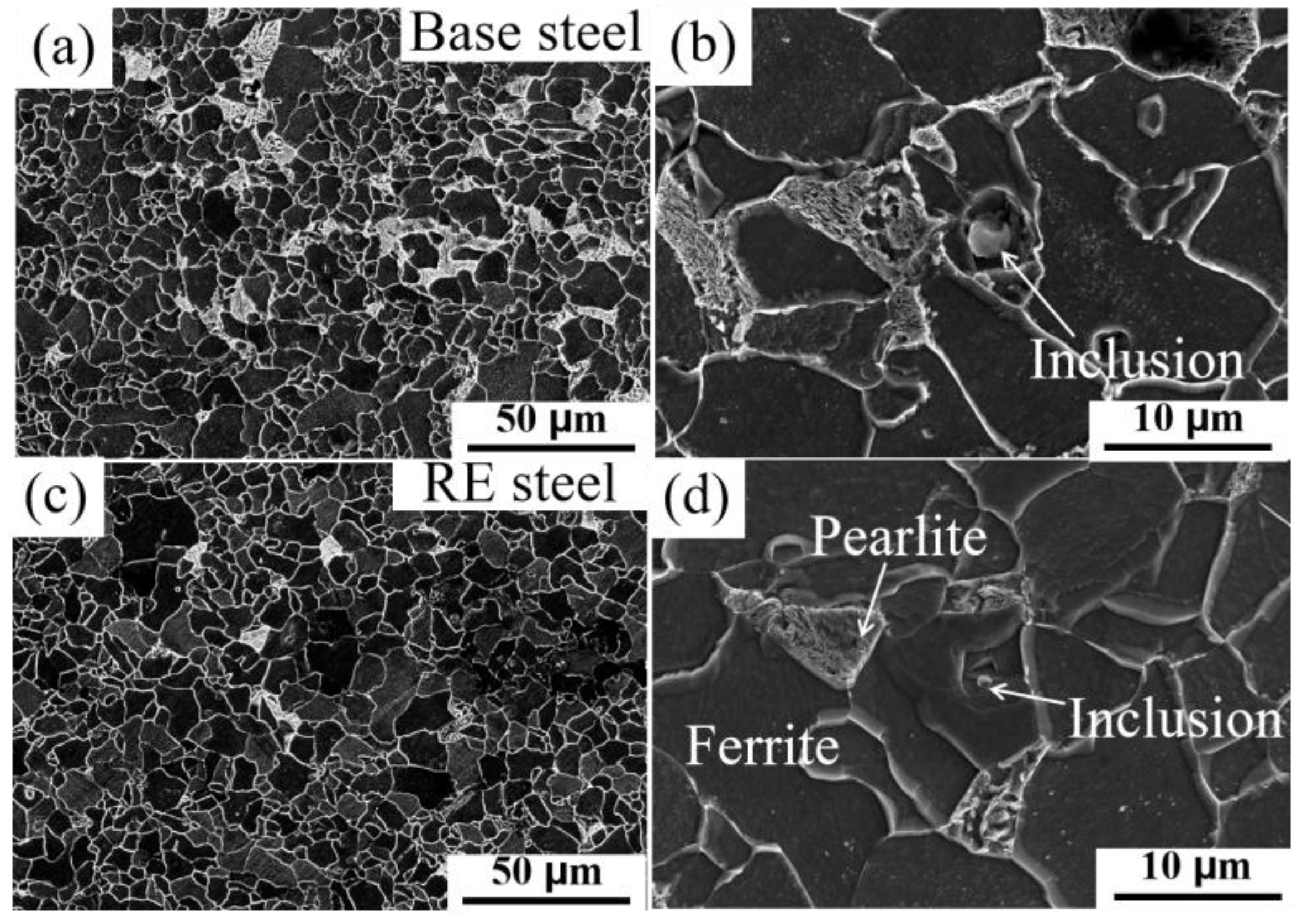
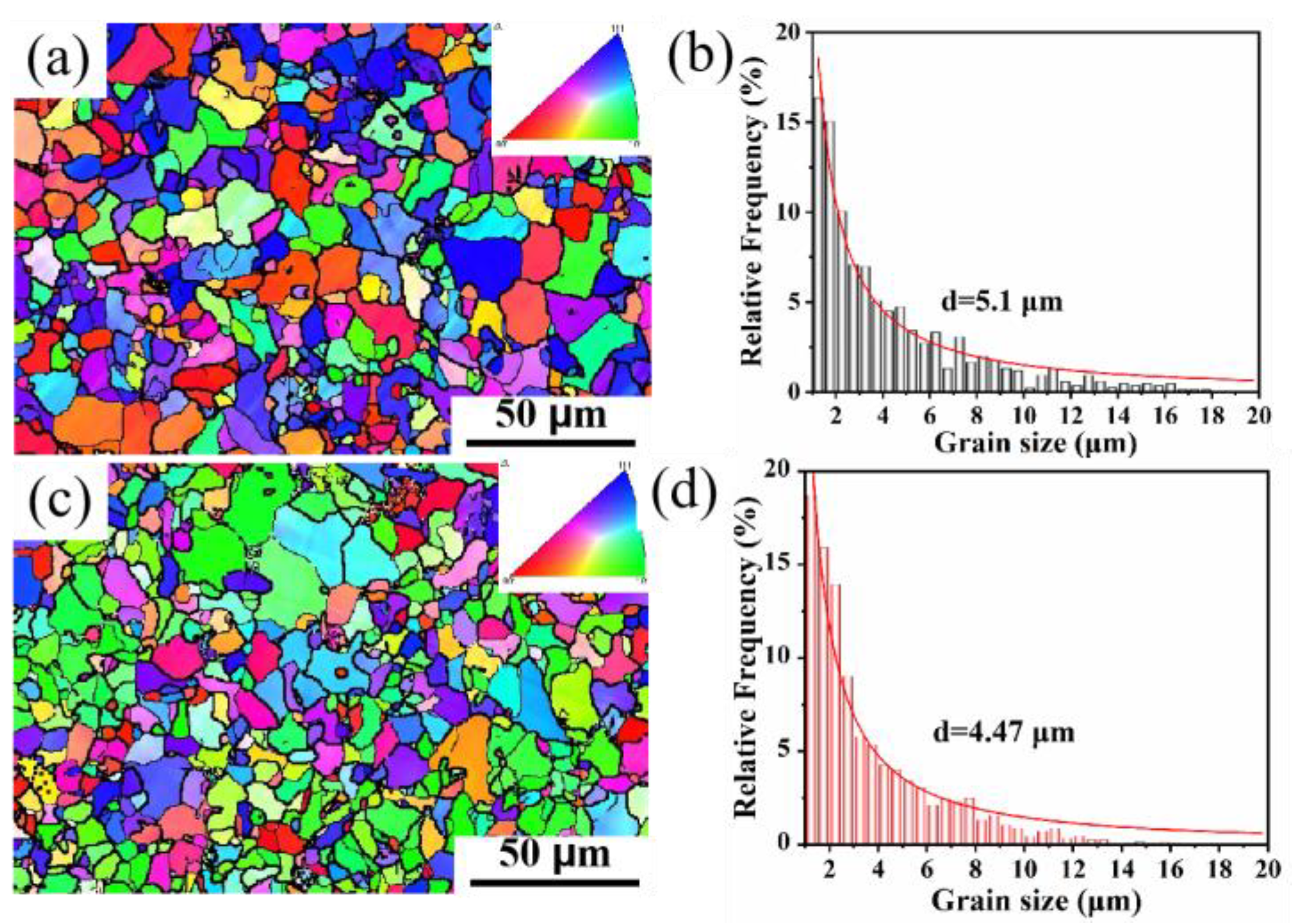
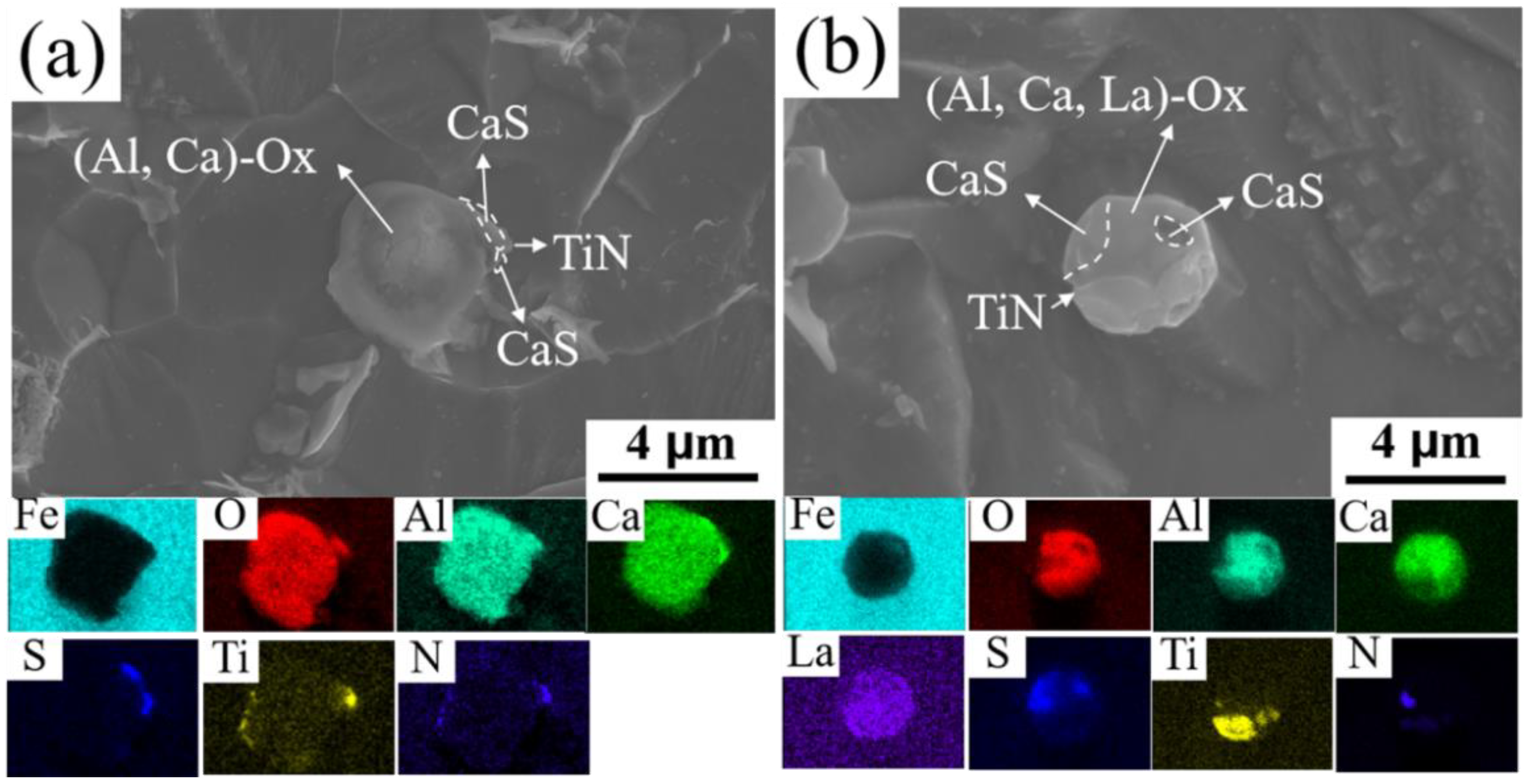
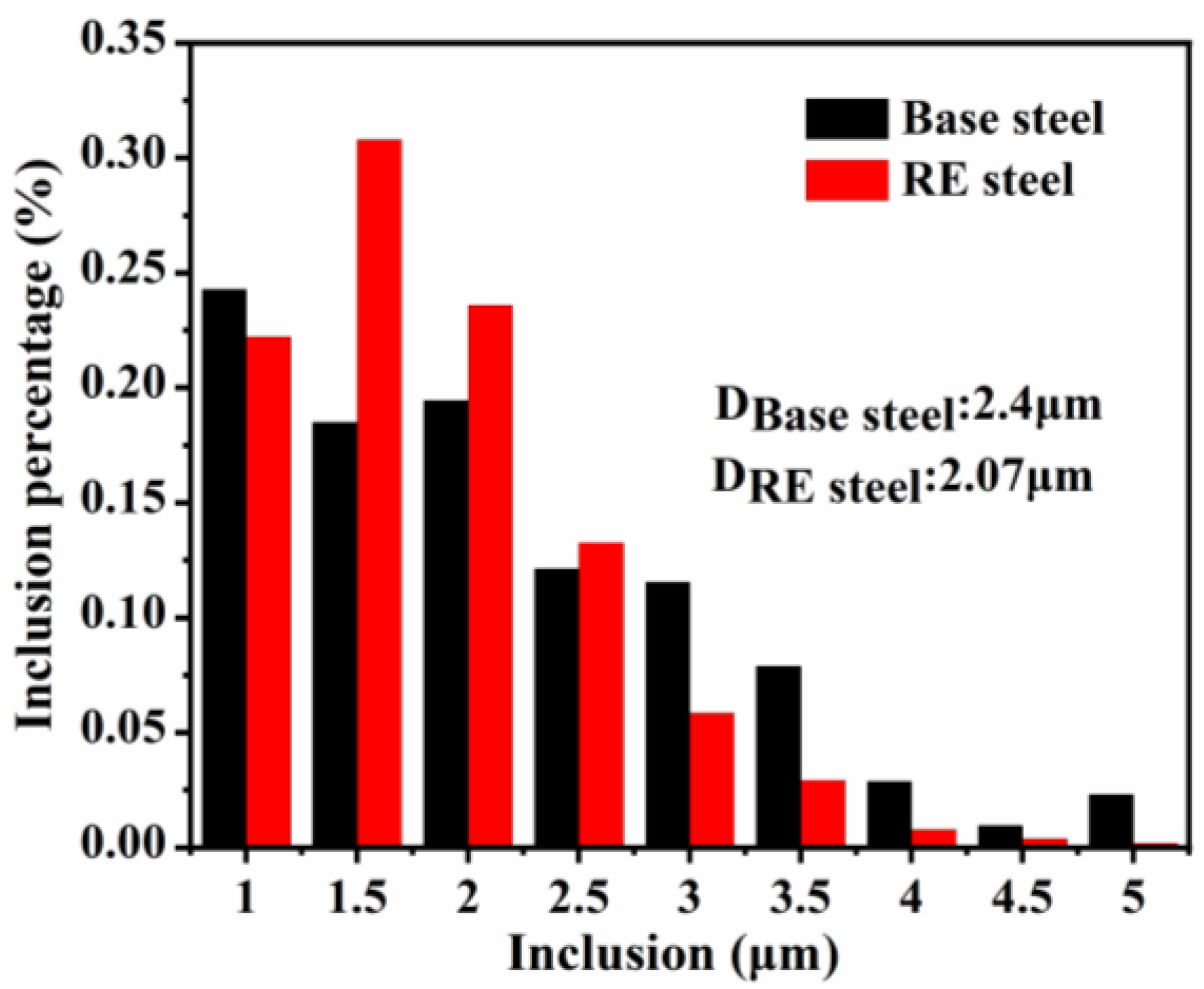

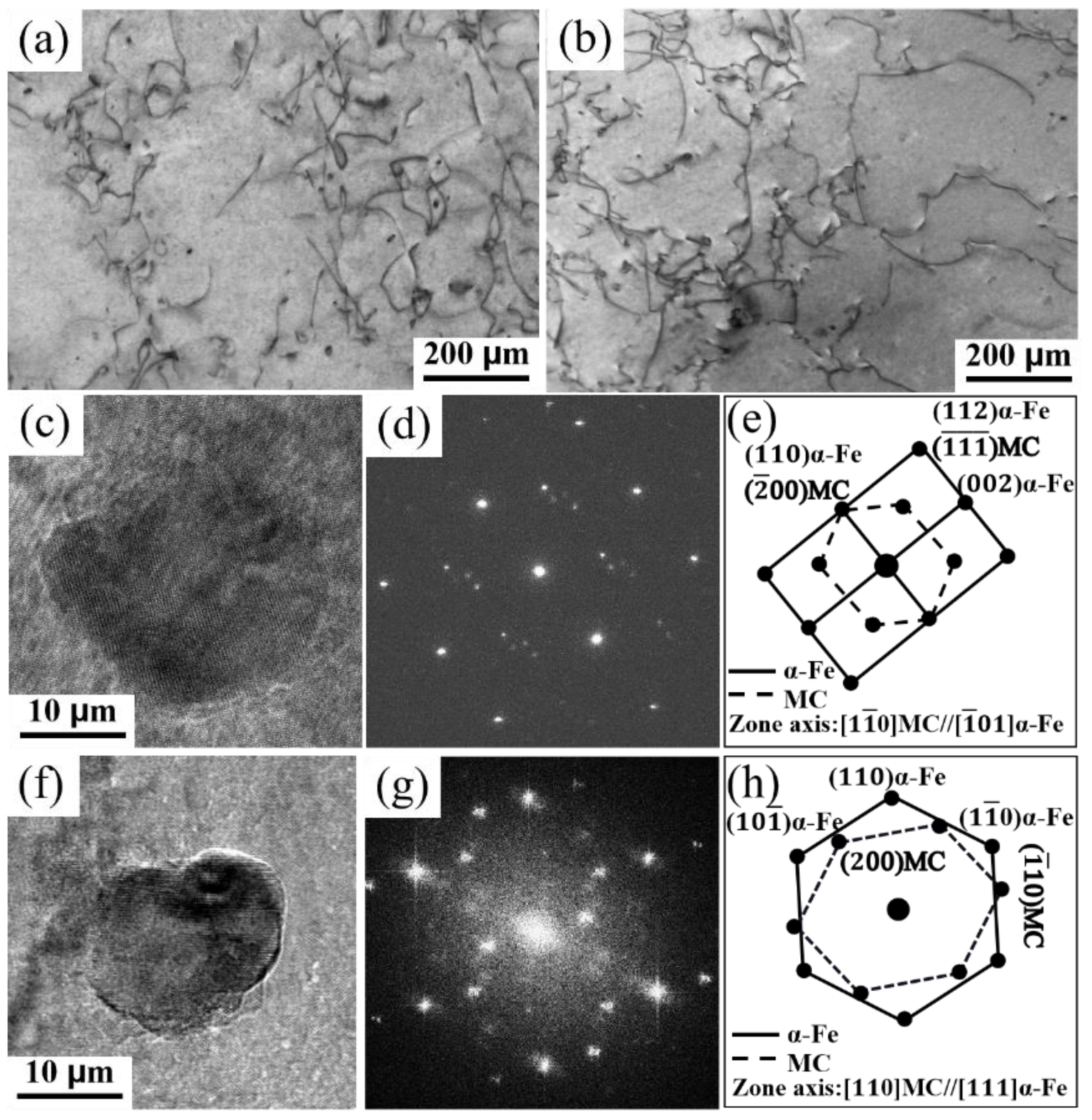
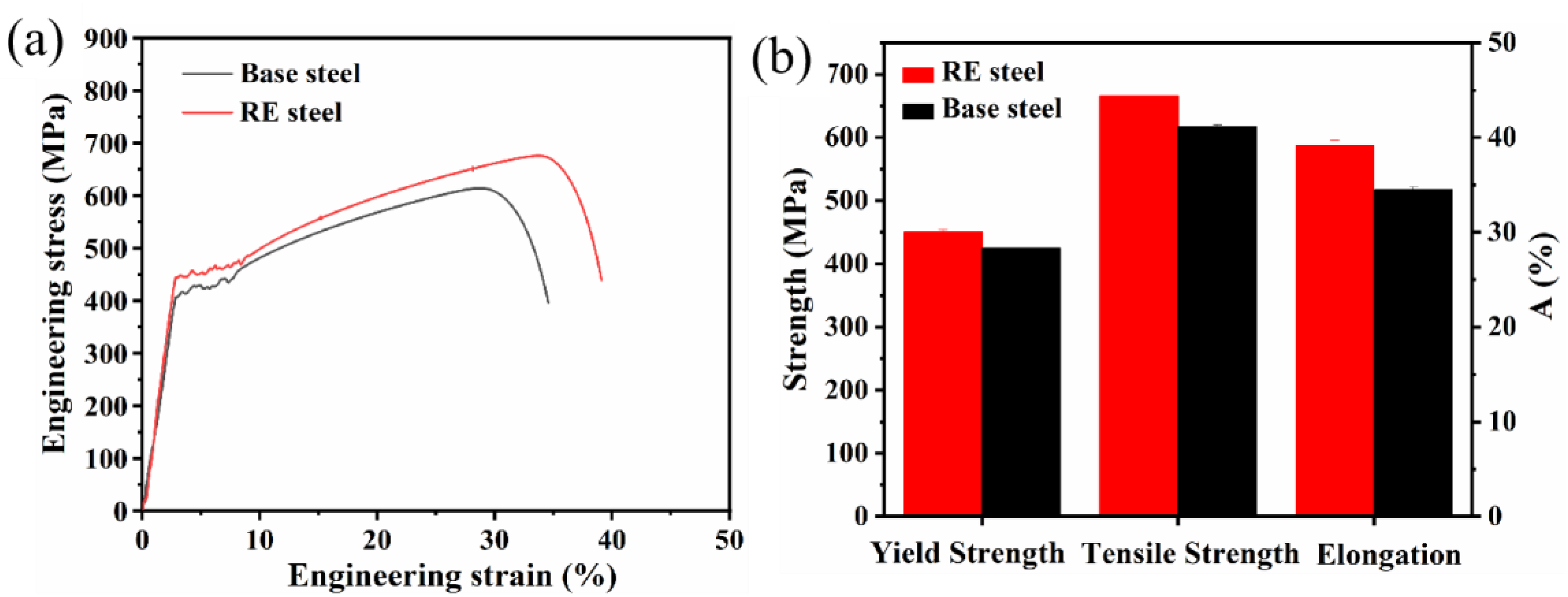
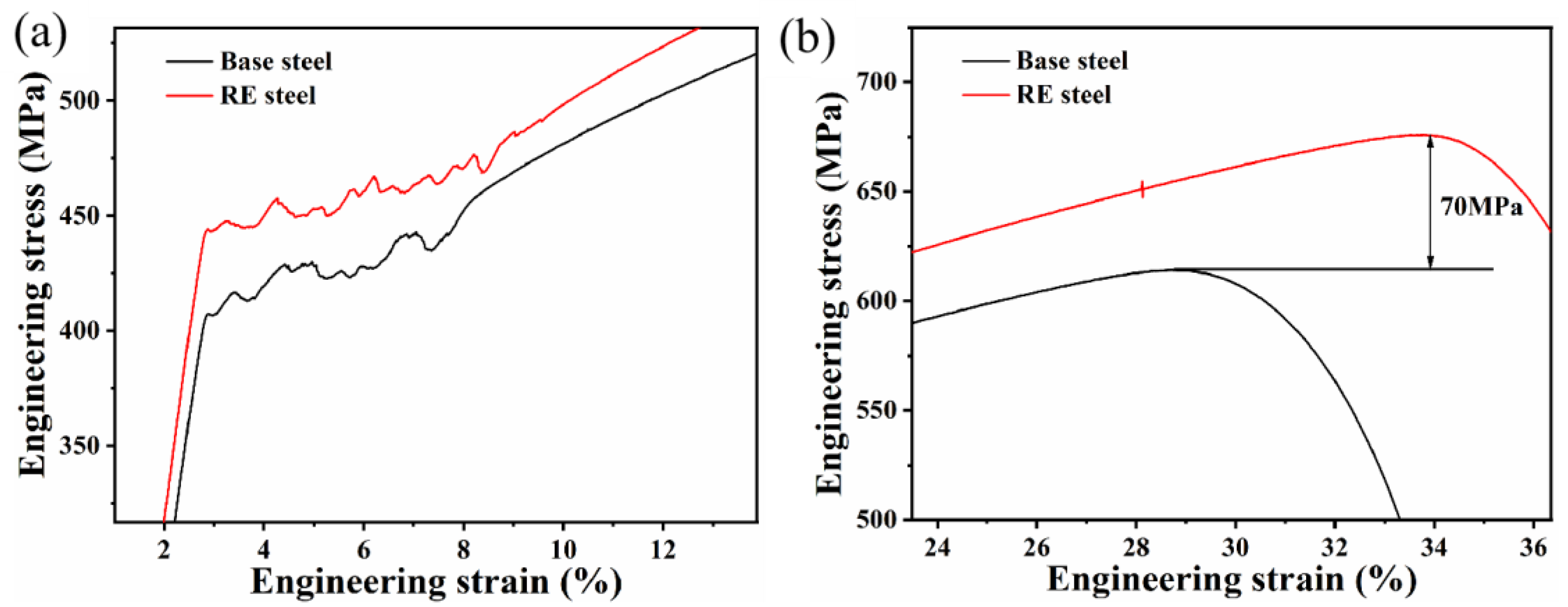
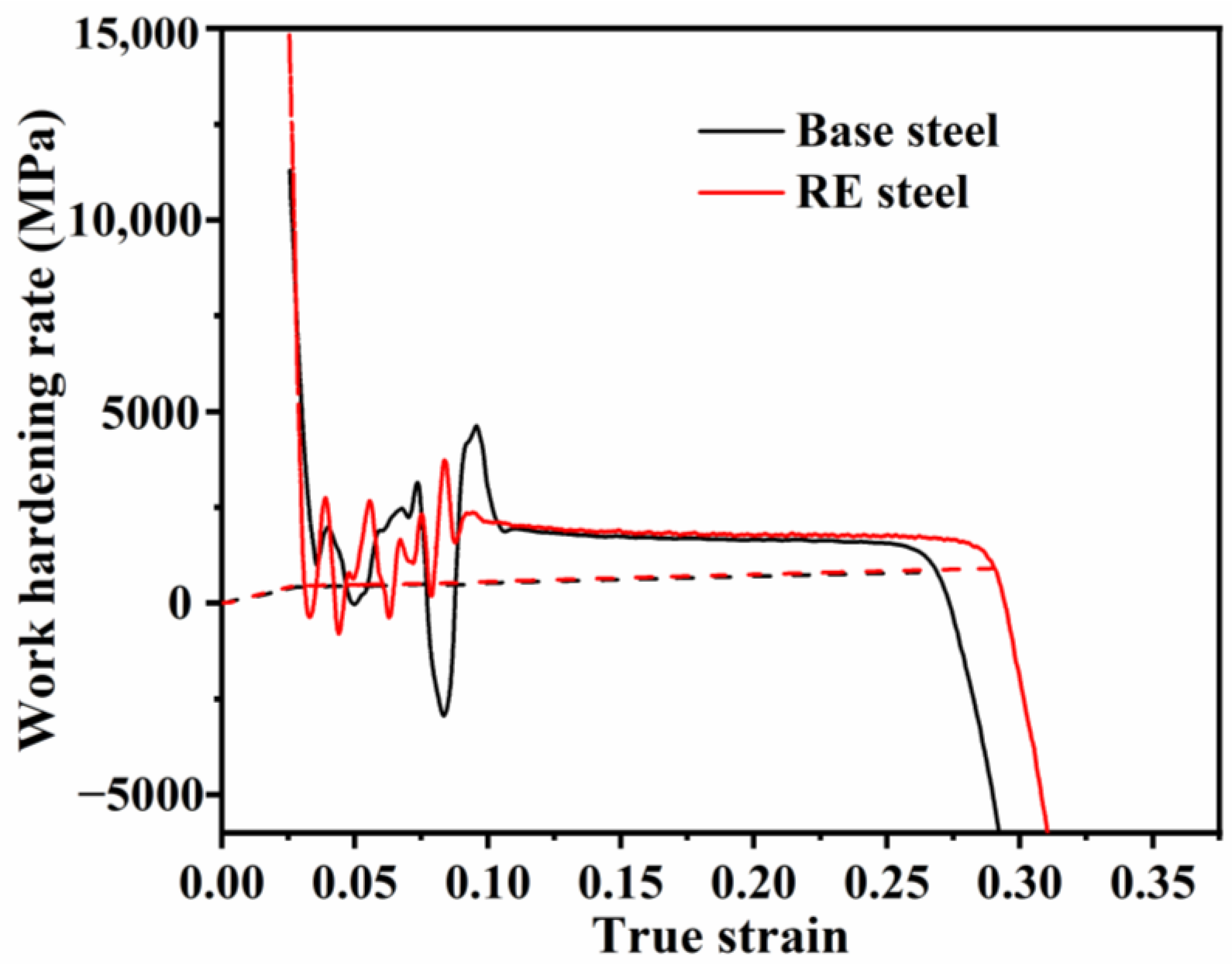
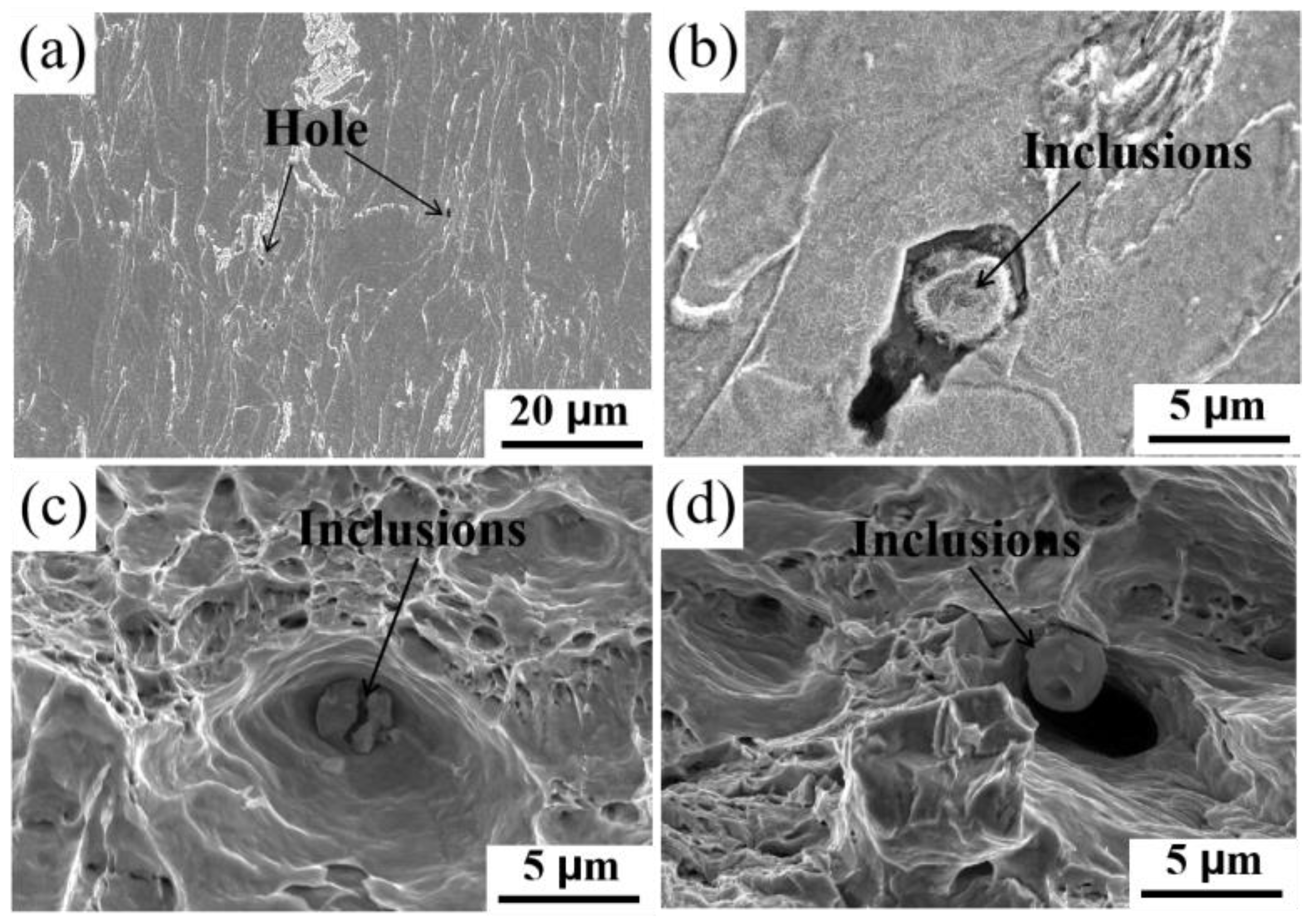
| Element (wt.%) | C | Si | S | P | Mn | Al | Nb | Ti | La + Ce | O |
|---|---|---|---|---|---|---|---|---|---|---|
| Base | 0.05 | 0.17 | 0.001 | 0.008 | 1.55 | 0.016 | 0.034 | 0.012 | - | 0.0047 |
| RE-added | 0.05 | 0.18 | 0.001 | 0.006 | 1.53 | 0.023 | 0.033 | 0.014 | 0.0075 | 0.0011 |
| Steels | Average of Pearlite Nodule Size (μm) | Average of Ferrite Grain Size (μm) | Pearlite (%) |
|---|---|---|---|
| Base | 6.1 ± 0.5 | 5.0 ± 0.7 | 21.6 ± 0.8 |
| RE-added | 4.3 ± 0.3 | 4.5 ± 0.8 | 21.1 ± 0.9 |
Disclaimer/Publisher’s Note: The statements, opinions and data contained in all publications are solely those of the individual author(s) and contributor(s) and not of MDPI and/or the editor(s). MDPI and/or the editor(s) disclaim responsibility for any injury to people or property resulting from any ideas, methods, instructions or products referred to in the content. |
© 2024 by the authors. Licensee MDPI, Basel, Switzerland. This article is an open access article distributed under the terms and conditions of the Creative Commons Attribution (CC BY) license (https://creativecommons.org/licenses/by/4.0/).
Share and Cite
Cheng, S.; Hou, T.; Zheng, Y.; Yin, C.; Wu, K. Effect of Rare Earth Elements on Microstructure and Tensile Behavior of Nb-Containing Microalloyed Steels. Materials 2024, 17, 1701. https://doi.org/10.3390/ma17071701
Cheng S, Hou T, Zheng Y, Yin C, Wu K. Effect of Rare Earth Elements on Microstructure and Tensile Behavior of Nb-Containing Microalloyed Steels. Materials. 2024; 17(7):1701. https://doi.org/10.3390/ma17071701
Chicago/Turabian StyleCheng, Shi, Tingping Hou, Yihang Zheng, Chaochao Yin, and Kaiming Wu. 2024. "Effect of Rare Earth Elements on Microstructure and Tensile Behavior of Nb-Containing Microalloyed Steels" Materials 17, no. 7: 1701. https://doi.org/10.3390/ma17071701




